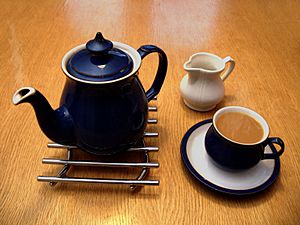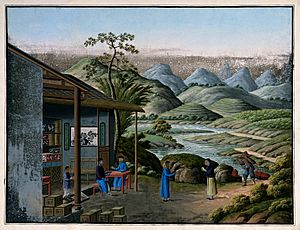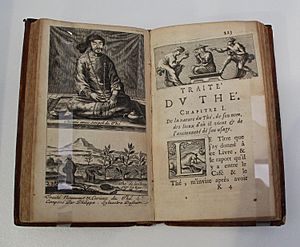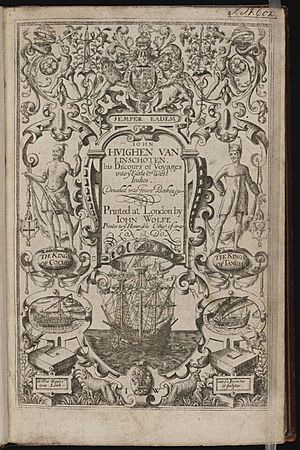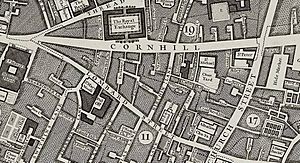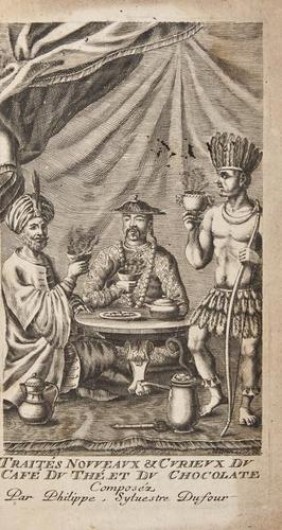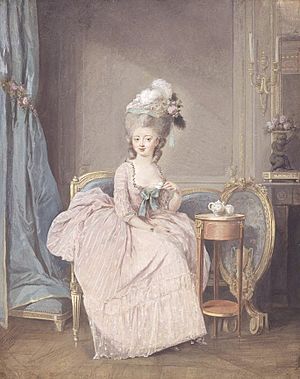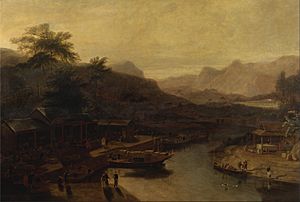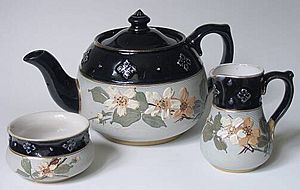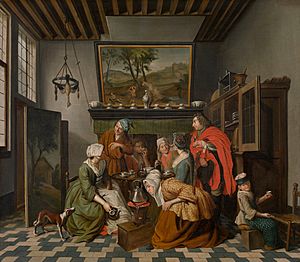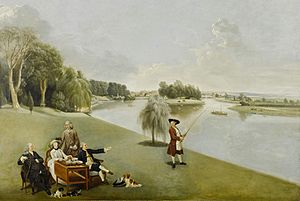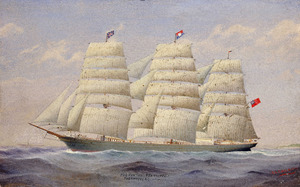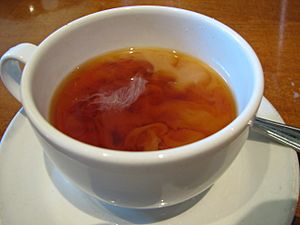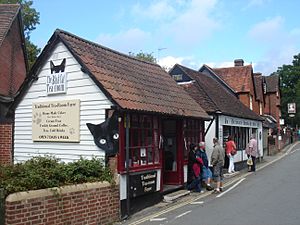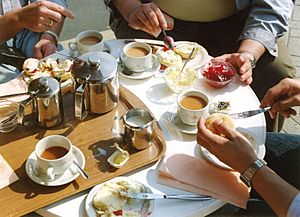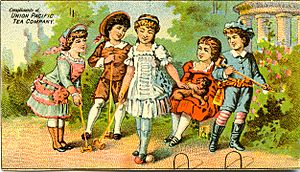Tea in the United Kingdom facts for kids
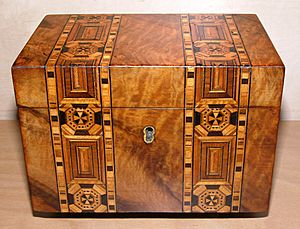
Since the 1700s, the United Kingdom has been one of the biggest tea drinkers in the world. On average, people in the UK drink about 1.9 kilograms (4.2 pounds) of tea each year! Tea was once a fancy drink for rich people in Europe. But over time, it became popular with everyone. Today, tea is a very important part of British culture and how people live.
In both the UK and Republic of Ireland, people like different kinds of tea. Most often, tea is served with milk. But some people drink it black or with lemon. Adding sugar is also very popular. Everyday teas, like English breakfast tea, are often served in a mug with milk and sugar. People often enjoy tea with snacks like sandwiches, crumpets, scones, cake, or biscuits. This led to the British custom of dunking a biscuit into tea!
Contents
The Story of Tea in Britain
Tea became very popular in Great Britain between the 1600s and 1800s. This had a huge impact on society, politics, and the economy. Tea became a symbol of good manners and home life. It also helped the British Empire grow and played a part in the Industrial Revolution. Tea showed how global trade could change a country and its people.
How Tea Arrived in Europe
Europeans first learned about tea in the mid-1500s. The earliest mention of tea in European books was in 1559. An Italian explorer named Giambattista Ramusio called it "Tea of China." Many years later, in 1598, a Dutch sailor named Jan Hugo van Linschooten wrote the first printed mention of tea in English.
The first known mention of tea by an Englishman was in 1615. Mr. R. Wickham, who worked for the East India Company, asked for "a pot of the best sort of chaw" from China. Another early mention was in 1625 by a trader named Samuel Purchas. He wrote that the Chinese drank tea as "the powder of a certaine herbe called chia." In 1637, a traveler named Peter Mundy saw tea in China and described it as "chaa – only water with a kind of herb boyled in it."
When Tea Began to Be Sold
Even with early mentions, tea wasn't sold in England until later. Green tea from China first appeared in London's coffeehouses before 1660.
Thomas Garway, who owned a coffeehouse, was the first to sell tea leaves and the drink in London in 1657. He even wrote a leaflet to explain this new drink! Soon after, the Sultaness Head Coffee House also started selling tea. They put the first newspaper ad for tea in 1658. It called tea an "Excellent, and by all Physicians approved, China drink."
By 1659, coffee, chocolate, and tea were sold "in almost every street." But tea was still mostly for the rich. Samuel Pepys, a famous diarist, tried tea for the first time on September 25, 1660. He wrote, "I did send for a cup of tee, (a China drink) of which I had never had drunk before."
The British East India Company first ordered tea in 1667. In 1669, they brought in 143 pounds of tea. In 1672, a servant in London sent instructions on how to make tea to someone in Shropshire. The instructions said to boil spring water, add a spoonful of tea, and sweeten it with sugar.
Tea as a Health Drink
One reason tea became popular was its reputation as a medicine. In 1641, a Dutch doctor named Nikolas Dirx wrote that "nothing is comparable to this plant." He claimed tea could cure headaches, colds, asthma, and more. Thomas Garway, the first English tea seller, also wrote about tea's health benefits in 1660. He said it "maketh the body active and lusty" and "strengtheneth the Memory."
Many other writers also praised tea's health benefits. In 1667, Samuel Pepys noted that his wife drank tea for her colds. These early scientists and doctors helped make tea popular as a medicine. However, some of them might have been influenced by trading companies who wanted to sell more tea. Still, these ideas about tea's health benefits helped it become more widely known in England.
Tea Becomes Fashionable
In the 1660s, tea was very expensive, much more than coffee. This made it a luxury item. At the same time, rich people in England started caring more about their health. This made tea even more appealing.
In 1660, the British East India Company gave King Charles II of England some tea from Portugal. His new wife, Catherine of Braganza, loved tea. She brought it to court in 1662 and made it fashionable among the ladies. She drank tea instead of alcohol, which made it an acceptable drink for both men and women. Wealthy ladies liked to show off their expensive tea, which made it even more popular. Adding sugar, another luxury item, also made tea more desirable for the rich.
By the 1680s, tea drinking was a big part of high society, especially for women visiting each other's homes.
Tea in the 1700s
While tea slowly became more common in coffee houses, the first tea shop in London opened in the early 1700s. Thomas Twining's tea shop, which opened in 1706, is still there today!
Tea became a British staple because more of it became available. Between 1720 and 1750, tea imports to Britain more than quadrupled. By 1766, British ships were bringing in 6 million pounds of tea from China.
At first, the British East India Company didn't trade directly with China. They relied on tea from Holland, which was expensive. But after 1700, the company started trading regularly with China. In 1720, the government banned Asian textiles, so traders focused on tea instead. This made tea more popular than coffee, which remained expensive. Also, as more tea and sugar were produced, their prices stayed low, encouraging more people to buy them.
Because people used tea bowls, they wanted to make their own porcelain like the Chinese. The first successful English porcelain was made around 1743-1745.
By the 1770s, all foreign tea came through London. But taxes on tea were very high. This led to a lot of tea being smuggled into Europe. Historians think about 7.5 million pounds of tea were smuggled each year before 1784.
Adding Milk and Sugar to Tea
Adding sugar helped tea become even more popular. The British started adding sugar to tea between 1685 and the early 1700s. Sugar was already a luxury for the rich. Since both tea and sugar were symbols of status, it made sense to drink them together. The amount of tea and sugar imported grew at the same time.
However, rich people also started worrying about sugar's health effects. Adding sugar to tea was seen as a way to enjoy sugar in a "healthy" way. Sugar also made bitter tea taste better. As more tea and sugar became available, drinking them together became very common. Black tea became more popular than green tea in the 1720s, especially when people started adding milk and sugar.
Tea for Everyone
Tea started as a luxury for the rich in Britain. But as prices dropped, more middle-class people could afford it. Drinking tea became a sign of good manners and respectability. Soon, tea drinking became a family ritual. This also increased demand. Tea became so important that it couldn't go out of style. Drinking tea was even seen as patriotic.
The British East India Company had control over the tea trade in England. This made tea more popular than coffee or chocolate. Tea was seen as truly British. The government encouraged tea drinking because they made money from taxing it. Unlike coffee and chocolate, which came from other countries, tea came from British colonies.
As Britain imported more tea, it went from being a respectable drink to a daily necessity. Even poor working-class people started drinking it. In 1767, a social reformer named John Hanway saw beggars and laborers drinking tea. Just two centuries after tea first appeared, it was popular with everyone, no matter how rich or poor.
Tea in the 1800s
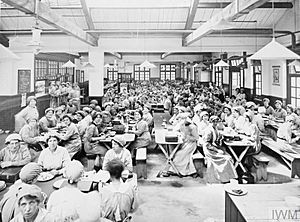
By the 1800s, tea was a daily need for working-class people. By the early 1800s, tea was cheaper than beer. Sugar was also very cheap, and people almost always drank tea with sugar. Even though coffee prices dropped, tea was preferred because it still tasted good when watered down. Poor people often diluted their tea to save money.
Tea had other benefits too. A hot, sweet drink helped dry bread and cheese go down easier. The warm drink was especially nice in Britain's cold, wet weather. Also, drinking tea required boiling water. This helped kill diseases like dysentery, cholera, and typhoid.
However, poor people drank tea differently. It was often drunk during work, not just at home. Laborers would brew tea outdoors and bring their tea tools to work. Afternoon tea might have helped workers get more energy to finish their day. The caffeine in tea, plus the calories from sugar and snacks, gave them a boost.
Growing Tea in India
Tea's popularity led to tea plants being secretly taken from China to British India. Tea farming began there in 1840. Between 1872 and 1884, more tea came to the British Empire as railways expanded. London soon became the center of the world's tea trade. With more tea, there was also a huge demand for teacups, pots, and dishes.
Tea Today
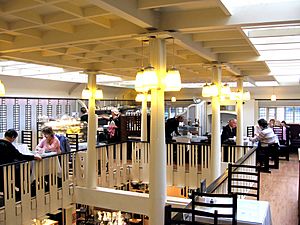
In 2003, a report showed that regular tea drinking in the UK was going down. Sales of normal tea bags fell by over 10% between 1997 and 2002. People were drinking more healthy drinks like fruit or herbal teas. Sales of these increased by 50%. Even so, tea is still a very popular drink and a big part of British culture.
How to Make Tea
Even for casual gatherings, people might use cups and saucers instead of mugs. Here's how a typical British tea ritual might go:
- The kettle is boiled with fresh water.
- Some boiling water is swirled in the teapot to warm it, then poured out.
- Tea leaves (loose or in an infuser) or tea bags are put into the teapot.
- Fresh boiling water is poured over the tea, and it brews for two to five minutes.
- The tea is poured into the cup. If using loose tea, a tea strainer is used. Infusers or tea bags can be removed when the tea is strong enough. A tea cosy might be put on the pot to keep the tea warm.
- White sugar and milk (usually in that order) can be added by the guest. Milk can also be put in the cup before the tea.
The teapot usually holds enough tea for everyone. If there's tea left, the tea cosy is put back on. Hot water might be offered in a separate pot to top up the teapot, but not for individual cups.
Milk First or Last?
By putting the tea in first and stirring as one pours, one can exactly regulate the amount of milk, whereas one is likely to put in too much milk if one does it the other way round. —One of George Orwell's eleven rules for making tea from his essay "A Nice Cup of Tea", 1946.
People have argued about whether to put milk in the cup before or after the tea since the mid-1900s. In his 1946 essay "A Nice Cup of Tea", author George Orwell wrote that tea "causes violent disputes over how it should be made." He said that "in every family in Britain there are probably two schools of thought on the subject."
Some people believe the order changes the tea's flavor. Studies suggest that heating milk too much when adding it after the tea can change the milk's proteins. Other studies say brewing time is more important. No matter what, adding milk does affect the flavor. Historically, the order of adding milk also showed a person's social class. Only rich people with good porcelain cups were confident that boiling water wouldn't crack their cups without milk in them first.
Another point of discussion is how the order affects how quickly the tea cools. One study found that adding milk first makes the tea stay hot longer. This is because fats in the milk can stop water from evaporating quickly, which helps keep the heat in.
Tea Drinking Manners
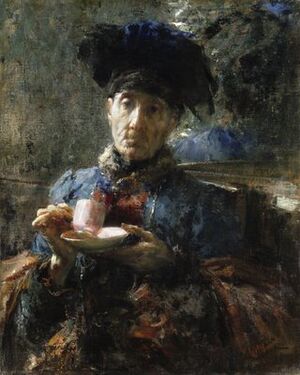
Britons also have ideas about the right way to drink tea with a cup and saucer. In the 1770s and 1780s, it was fashionable to drink tea from saucers. These saucers were deeper, more like bowls. If you are sitting at a table, you should only lift the teacup, putting it back on the saucer between sips. If you are standing or sitting without a table, hold the saucer in one hand and the teacup in the other. When not drinking, put the teacup back on the saucer and hold it in your lap or at waist height. The teacup should never be waved in the air. Your fingers should be curled inwards; no finger should stick out from the handle.
Tea Rooms
Tea rooms became popular partly because people were worried about workers drinking too much alcohol. The temperance movement promoted tea as a healthy choice instead of alcohol. Many new cafes and coffeehouses opened in the 1830s as places to socialize without going to a pub.
In 1864, the Aerated Bread Company opened the first of its "A.B.C. Tea Shops." The idea came from a manageress who served free tea and snacks to customers. By 1923, A.B.C. tea shops had 250 locations. J. Lyons and Co. also started tea rooms in 1894 and became the biggest chain. Their waitresses were called "nippies" because they were so fast.
In 1878, Catherine Cranston opened her first Miss Cranston's Tea Room in Glasgow, Scotland. These were elegant places where women could socialize without men. They became very popular. She hired famous designers like Charles Rennie Mackintosh, who designed the beautiful Willow Tearooms.
Tea rooms were also important because they gave women a safe and respectable place to eat without a male escort. They helped women gain independence and support the fight for the right to vote.
Many hotels in London have a long tradition of serving tea. For example, Brown's Hotel has served tea for over 170 years. By the 1880s, fancy hotels in the US and UK had tea rooms. By 1910, they even hosted afternoon tea dances.
Tea rooms were common in Britain until the 1950s. Then, cafes became more popular. But you can still find many places that offer afternoon tea. This is a fancy light meal with savory snacks like tea sandwiches and small pastries. A simpler option is a cream tea, popular in the West Country. It includes a scone with jam and clotted cream. Another meal is high tea, which is a hot, savory meal eaten in the early evening. In Scotland, teas often come with scones, pancakes, crumpets, and other cakes.
Tea Breaks
British workers have a legal right to a break of at least 20 minutes in a six-hour shift. Government rules call this a "tea or lunch break." Informally, a tea break around 11 a.m. is called elevenses. A mug of Builder's tea is a common drink during a quick tea break at work.
Tea as a Meal
The word tea can mean not just the drink, but also a light meal. Anna Russell, Duchess of Bedford, is said to have created this meal around 1840. The idea of having cakes or a light meal with tea spread to tea houses. In the West Country, cream teas are a special treat. They include scones, clotted cream, and jam with your tea.
Afternoon tea today is usually a special event. It might be in a hotel dining room, with savory snacks like tea sandwiches and small sweet pastries. Queen Victoria loved sponge cake with her afternoon tea. After Alfred Bird invented baking powder in 1843, cakes could rise higher. A patriotic cake, Victoria sponge, was named after the Queen.
A social gathering to enjoy tea together, often at home, is called a tea party.
Tea or high tea can also mean a hot, savory meal eaten in the early evening. This is common in working-class British English, especially in Northern England, Scotland, and Northern Ireland.
Tea Cards
In the UK, some loose tea sold in packets from the 1940s to the 1980s came with tea cards. These were small, illustrated cards, like cigarette cards, that children collected. Some of the most famous were from Typhoo tea and Brooke Bond. Brooke Bond even provided albums for collectors.
Some famous artists drew pictures for these cards. Many of these card collections are now valuable collector's items.
In the early 1990s, PG Tips tea released a series of pogs with pictures of tea cups and chimpanzees. Tetley's tea also released pogs, but they weren't as popular as PG Tips'.
|


